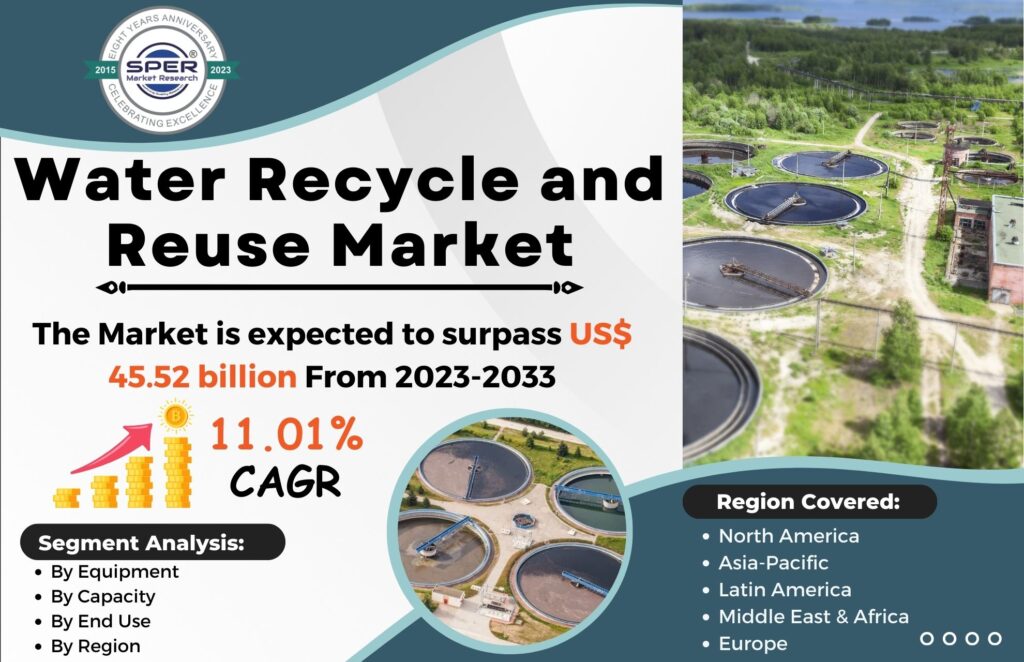Water Recycle and Reuse Market Trends 2023- Global Industry Share, Revenue, Growth Strategy, Business Challenges, Opportunities and Future Competition Till 2033: SPER Market Research

Water recycling and reuse encompasses a variety of methods that include gathering, cleaning, processing, reclaiming, and reusing wastewater produced by different industries and sources for a range of uses, such as street cleaning, vehicle washing, and irrigation. Standard procedures for recycling and reusing water include desalination, reverse osmosis, fine filtering, aerobic biological treatment, and trapping. Mounting concerns over water scarcity are a primary driver of market growth. In parallel, there is a rising awareness among consumers about the environmental damage resulting from resource shortages. This, along with the increasing requirement for efficient water recycling and reuse methods to treat industrial and human-generated wastewater for both drinking and non-drinking purposes (such as toilet flushing, agricultural irrigation, and industrial processes), represents another substantial growth catalyst. Government-led water conservation initiatives, prompted by mounting environmental anxieties, are also propelling the market.
According to SPER market research, ‘Water Recycle and Reuse Market Size– By Equipment, By Capacity, By End Use- Regional Outlook, Competitive Strategies and Segment Forecast to 2033’ state that the Water Recycle and Reuse Market is predicted to reach USD 45.52 billion by 2033 with a CAGR of 11.01%.
These programs, along with significant investments, have fostered the development of wastewater storage infrastructure, facilitating the distribution of treated water for personal consumption. Additionally, the extensive utilization of recycled water in construction, like concrete mixing, artificial lake creation, and industrial use, is positively impacting market expansion. Growing demand for recycled water in agriculture, along with continued education on diverse water recycling methods and their benefits by governmental and non-governmental organizations (NGOs), is fostering a favourable market outlook. The need for recycled water in groundwater aquifers and surface reservoirs, coupled with the emergence of cost-effective water quality monitoring and contaminant identification technologies, further bolsters market growth.
However, aside from financial obstacles and physical issues at the plants, there are technical and operational difficulties with water recycling and reuse. An efficient system for recycling and reusing water can be expensive to set up and operate. This is because recycling water needs to be transported and stored, which calls for sophisticated treatment technologies and a sizable infrastructure, including pipelines and storage facilities. To fulfil certain quality standards for its intended application, recycled water could also need extra treatment, which raises the overall cost.
Request For Free Sample Report @ https://www.sperresearch.com/report-store/water-recycle-and-reuse-market.aspx?sample=1
Impact of COVID-19 on Global Water Recycle and Reuse Market
Furthermore, for the water recycling and reuse sector, the COVID-19 epidemic had both beneficial and harmful effects. Water security is crucial, and efficient water management is required, as the epidemic brought to light. Water recovery technology became more and more in demand as people became more conscious of cleanliness and hygiene, particularly in public spaces like hospitals. The market was badly damaged by this drop in water use.
Water Recycle and Reuse Market Key Players:
Geographically, Asia Pacific led the global water recycling and reuse market in terms of value. China is the biggest market in the Asia-Pacific area. In light of the substantial industrial and commercial sectors, population expansion, and urbanisation, it is expected to increase at the fastest rate over the projected period. Additionally, some of the market key players are Alfa Laval, Dow Chemical Company, Evoqua Water Technologies, Veolia Water Technologies, Others.
Water Recycle and Reuse Market Segmentation:
The SPER Market Research report seeks to give market dynamics, demand, and supply forecast for the years up to 2033. This report contains statistics on product type segment growth estimates and forecasts.
By Equipment: Based on the Equipment, Global Water Recycle and Reuse Market is segmented as; Drains, Filtration, Machinery, Pipes, Tanks.
By Capacity: Based on the Capacity, Global Water Recycle and Reuse Market is segmented as; <25,000L, 25,001 TO 50,000 L, 50,001 L TO 100,000 L, > 100,001 L.
By End Use: Based on the End Use, Global Water Recycle and Reuse Market is segmented as; Commercial, Industrial, Residential.
By Region: This research also includes data for North America, Asia-Pacific, Latin America, Middle East & Africa and Europe.
This study also encompasses various drivers and restraining factors of this market for the forecast period. Various growth opportunities are also discussed in the report.
For More Information, refer to below link:-
Water Recycle and Reuse Market Future Outlook
Related Reports:
Follow Us –
LinkedIn | Instagram | Facebook | Twitter
Contact Us:
Sara Lopes, Business Consultant – U.S.A.
SPER Market Research
+1-347-460-2899





